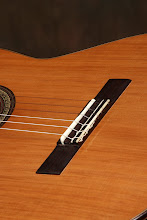People are often amazed at the variations of sound they hear from my guitars. After hearing several sound samples, and even a live demo, a prospective client once told me that, although he liked all the guitars he had heard, he wanted me to assure him that I could faithfully replicate the sound of the “sweeter sounding” guitar.
He didn’t know yet that all the samples he had heard were played on the same guitar.
His concern was understandable, but it brings up an interesting point about how we judge the sound of a guitar. Modern guitar designs are challenging players and audiences alike to think about “what a guitar sounds like” a little differently.
Because you have two hands to work with, each doing something totally different to any given string, the classical guitar has one of the most bendable, variable sounds of any instrument. You can vary the sound with the right hand by choosing different flesh to nail ratios, the angle at which you strike the string, the shape and length of your nails, and playing closer to or further from the bridge. Your left hand has the option of adding vibrato, staccato, glissando, legato, etc.
The net effect of all these variables is that the player can change the way the string vibrates. The player chooses (consciously or not) whether the string will bounce more up and down, side to side, or horizontally, and to what degree the main frequency will be supplemented by the strings natural harmonics (playing over the sound hole vs. near the bridge). In other words, you can fret and pluck the string in a million different ways, each causing the string to vibrate in a unique way.
Modern designs that incorporate lightweight composites for bracing and/or soundboard material tend to have wider tonal and dynamic palates. For example, my
TRIPLE CORE TM design has a very light weight soundboard braced in a way that allows the various types of sounds the guitar is capable of producing to each sing in its own way. The soundboard acts almost like a set of speaker cones, faithfully reproducing each variation of the vibrating string. Each tiny nuance that travels from your brain, to your fingers, to the strings is picked up by the soundboard.
This is true of other designs to a lesser degree. Besides the obvious loss of power, necessarily heavier built fan braced designs, and even many lattice designs and double tops with excessively heavy bracing, tend to filter out a lot of the anomalies from the vibrating sting, reducing the amount of nuance that you can impart to the sound. A guitar like this can sound sweet and beautiful, but it can’t do a whole lot more than that.
The unfortunate side effect of these otherwise lovely guitars is that their players can develop uninspired technique: why put the effort into nuancing your hand movements when it doesn’t change the sound? This is especially true of the right hand. Too often it tends to stay put, without moving up or down the strings much, and the angle of attack of each pluck seems to be determined by the player’s method books, and not the requirements of the piece at hand.
Many players are taught to use rest strokes whenever possible, and to rest free fingers on strings to build leverage. Others are taught to always pluck upwards, for much the same reason. These methods were developed by old masters for a reason – you need to get a lot of energy into a string to make a traditionally built guitar sing. These particular styles are fine – some of the time - but what if you want your guitar to sound different? Modern designs are capable of so much more that it’s a shame to limit your playing technique to such a small tonal and dynamic range. Smooth glancing plucks (diagonal to string) with the edge of a well rounded fingernail is not only easier on your hands, it can impart a round tone that a harsh perpendicular pluck might lack.
Fingernail length might also be adjusted to suit a more modern guitar design. Since you no longer need the leverage from excessively long nails, try trimming them fairly short and round with a well polished edge. The tone colors you will be able to explore will expand your musical toolbox, and playing will likely become easier.
Playing style and fingernail length are, of course, personal preference. The point is, explore! With a highly sensitive guitar, it's worth trying new things.
If you are in the market for a professional level guitar, I hope that you will consider a
TRIPLE CORE TM and free your hands from the shackles of outdated methods and techniques!
-Tomas
http://www.latticeguitars.com/
Please
email me if I can answer any questions - I'll be glad to help!









